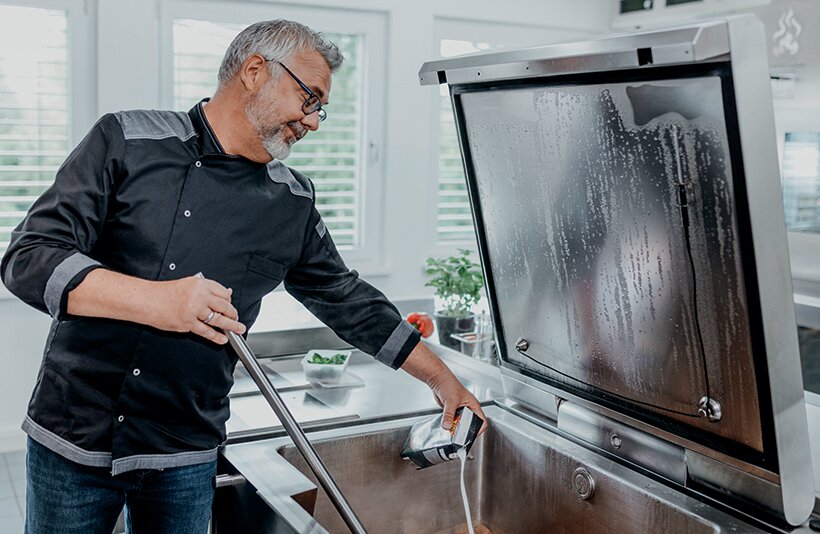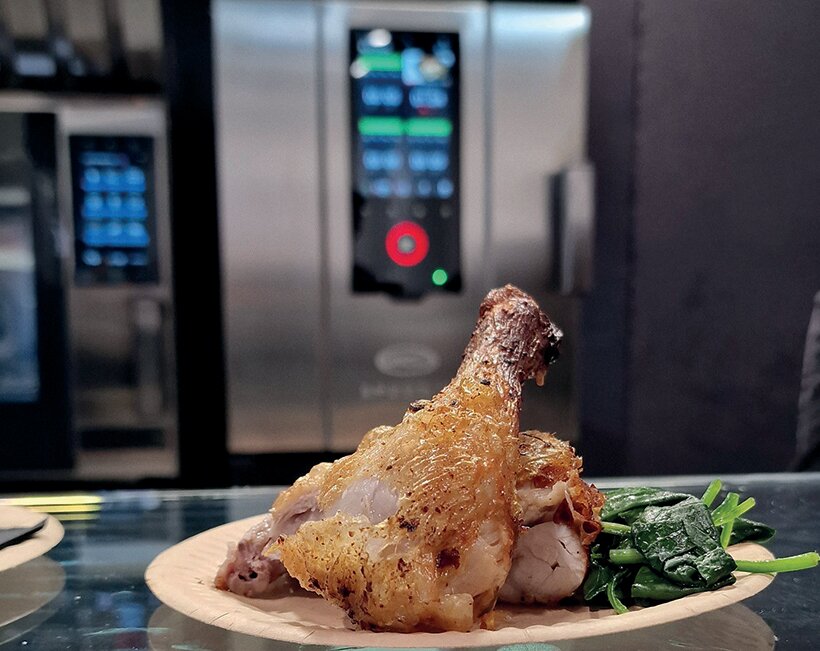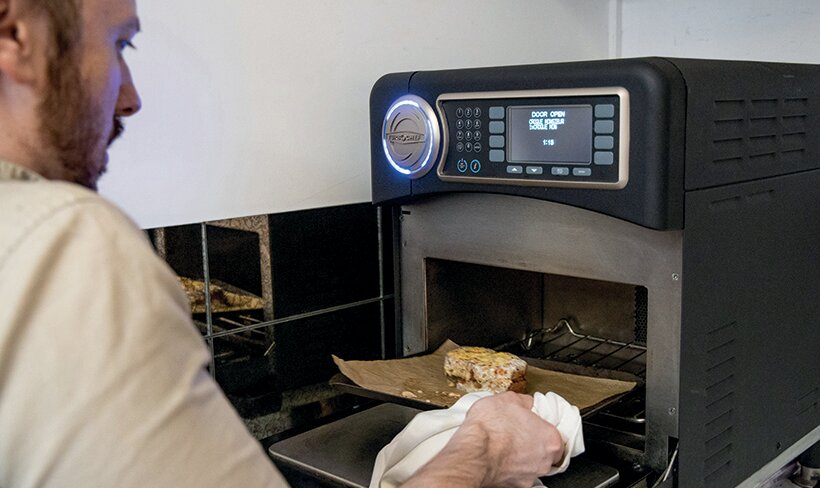Fast food: new uses for rapid cooking equipment
Speed is the name of the game when it comes to serving customers quickly. Ian Boughton looks at the latest in rapid cooking
Speed is the name of the game when it comes to serving customers quickly. Ian Boughton looks at the latest in rapid cooking
The dash for increased speed in the kitchen is having some interesting results, as chefs take equipment intended to offer accelerated cook times and use it to aid their creativity.
There was a trend some years ago for restaurants to use the tagline: ‘We don’t serve fast food – we serve good food, fast!’ That developed into the concept of ‘rapid cooking’, which is good food served at extremely high speed.
The ‘accelerated’ and ‘high-speed’ sectors have gained ground at a remarkable pace. Equipment which was maybe devised for high street grab-and-go sites, with cooking times for takeaway items down to mere seconds, has been taken up by more serious kitchens as chefs of all kinds develop their own ways of using the newest technology.
It has all happened because of the discovery that several different methods of accelerated heating could be combined in a single piece of equipment. And with this realisation came the imaginative advance of chefs looking to see just what else they could do with the equipment – and every supplier knows that when a user gets their hands on a piece of kit and starts experimenting, they are likely to come up with ideas that even the manufacturer had not thought of.
“Accelerated cooking first became popular due to demand for food on the go, fast,” agrees Andy Threlfall, technical director of the Foodservice Equipment Association (FEA). “The quick-service restaurants needed to get heated food out more quickly, but they also needed to achieve better quality.
“It was found that combining microwave technology with another heat source, such as convection, infra-red or impingement, provides faster cooking as it heats both the core of the product and the surface. It was also found that this generally makes for a better presented product, since it is browned or crisped as well as heated. It is particularly useful as it maintains the texture and appearance of the food being heated.”

Rapid growth
The development into new sectors can be seen clearly, says Alistair Farquhar, national sales manager at Welbilt: “A few years ago, the coffee shops, cafés and fast-food restaurants were the sub-sectors placing the most orders for rapid-cook equipment. Now we see that many high-end hotels, pubs and restaurants are also starting to embrace various high-speed cooking technologies. We have seen substantial demand from these establishments for the Merrychef Connex.This is due not just to a shift in customer expectations for quality food served fast, but also to back of house working dynamics – many kitchens are now operating with fewer chefs and porters.”
The Connex, he notes, can be used for such diverse items as soups, omelettes and baked Camembert. It also increases communication between different sites within a group: “Merrychef models come with 100 pre-programmed recipes produced by our team of chefs – the user simply needs to select, press and go. Hotels and restaurants can also take control of this by creating their own recipes and inputting these, and through the Connex Wi-Fi connectivity, multi-site restaurants and hotel chains will inevitably reap the benefits of being able to upload shared menus, meaning each site can serve the same menus at the touch of a button.”
Speed of service is matched by economies of use, says Stuart Flint, training and demonstration manager at Electrolux: “Caterers have had to battle both a staffing crisis and soaring energy costs. Our GourmeXpress combines convection, microwave and impingement cooking technology in one low-footprint countertop oven, and the different cooking technologies allow caterers to curb unnecessary power consumption by using the most appropriate mode for each dish.
“It can be used for both savoury and sweet options, and can cook two portions of lasagne in 90 seconds, a tray of six pizza slices in 80 seconds, and a portion of six chicken wings in four minutes.”

Juggling act
What creative chefs have been quick to understand is that different technologies allow for the clever juggling of mixed dishes at the same time.
“One of the most important elements in getting food out quicker is to have it ready ahead of service,” says Wayne Bennett, sales and marketing head for MKN. “The FlexiChef from MKN leads the way for high-speed production cooking – it is a multi-award-winning piece of equipment that lets kitchen staff fry, steam, boil, deep-fry, high-speed cook or sous vide at high speed, all in one appliance.
“The FlexiChef is up to two times faster than conventional pressure cooking technology and up to three times faster than conventional cooking equipment. It’s essentially a very modern tilt skillet, which can high-speed cook – a risotto takes 11 minutes instead of 30 minutes. The FlexiChef pan can be used as a standard griddle plate or pan and then be used for a variety of other cooking tasks, such as frying, stewing and braising.
“But it offers huge flexibility too, with different levels of high-speed cooking. The pan cooking surface can be split into different zones, which allows different items to be cooked at different temperatures on each zone – therefore, one pan surface could cook multiple items at the same time, such as a full English of bacon, egg and mushrooms.”
It is important to remember that rapid cooking is not a new concept, says product manager Andrew Whyte at Panasonic. What has driven the current growth is the creative understanding of what chefs can do with it, through an improved grasp of how the technology works.

“Innovation in rapid cooking has been led by the combination of menus expanding, the customer expectation of reduced waiting time and fewer chefs in a kitchen,” he says. “Increasingly, we’re seeing interest from the likes of gastropubs, formal restaurants and luxury hotels, many of them finding truly creative ways to use the equipment, including baking, grilling, roasting and browning, all to highly repeatable standards.
“The Panasonic NE-SCV-2 is designed to cook, toast, bake, grill and reheat, for both fresh and frozen foods, from baking-off pastries to meat, vegetables and even delicate items such as fish. It shows how the latest rapid cook and multifunctional equipment can benefit grab-and-go operators and dedicated professional kitchens alike.”
“Although the majority of users of rapid cook ovens tend to do similar products such as toasties, paninis and pastries, there are a few instances where we have been amazed by what people have been able to achieve, including different types of tapas-style dishes. We really enjoy seeing desserts coming from the oven – perfectly-cooked chocolate fondants in under one minute, tarte au citron and even mini meringues.”
Petite and neat
The latest high-speed products are smaller, say several suppliers, and this leads to even more new ideas.
“A greater variety of businesses are relying on accelerated cooking to help them deliver quality food quickly,” says David Rees, group marketing manager for HTG Trading and Taylor. “Hideaway, the café spin-off of London restaurant Hide, offers a range of freshly cooked baguettes, bagels and rolls, which are produced in the main kitchen at Hide. We installed a Turbochef Sota rapid-cook oven, letting Hideaway take the standard coffee shop menu to a new level, with examples like their caviar pizza, or the truffled croque monsieur, which combines sourdough, artisanal cheese and freshly shaved black truffle.
“The pandemic boosted the growth of home delivery and dark kitchens and another company we are working with has taken this to a new level by making their kitchen mobile – hot food is prepared en route and finished at the customer’s address, allowing the food to be served hot as it has literally just been cooked.
“This is made possible by the development of 13-amp versions of rapid cook ovens. Since this version can operate from a mobile generator, it is a lot easier to take it out on the road.”
Smaller units have become useful, agrees Michael Eyre, product director at Jestic: “The XpressChef 3i advanced high-speed oven from ACP incorporates three cooking technologies – impingement, convection and microwave assist – to give fast cooking results in an easy-to-use way. It has a minimal footprint, with a maximised cavity design which fits on a 71cm counter and still easily accommodates a 12-inch pizza. They have certainly earned their place in the kitchen.”
Rational has made the comment that with its iVario, users can cook up to four times as fast and with 40% less energy: “It’s all in one now!” remarks the brand, pointing to several operators who have adopted this “technologically advanced bratt pan”, and have also incorporated Rational’s Connected Cooking system. This is a cloud-based networking system which allows an operator to manage menus, recipes, cooking programmes, assets and servicing diagnosis, and operational hygiene reporting, across all sites. If required, an operator can tell when a cooking process has finished, the remaining cooking time or which units will next become free across a business’s entire estate.
Tom Wilkinson owns Replenish Kitchen, which offers a range of healthy meal kits inspired by world cuisine and produces more than 600 meals a day, many requiring different cooking techniques. He says he is able to produce larger batches more easily and consistently and his turnaround time has been “reduced significantly”.

Rehan Uddin of the Indi-Yang restaurant in Torquay and managing director of the Asian Restaurant Owners Network, says the Rational system has enabled him to build a “smart food experience”, in which two staff can achieve the same output as a much larger kitchen in a fraction of the time. He also reports significant savings on energy bills due to the reduction of prep time.
At Unox, managing director Scott Duncan says it is when chefs get their hands on new equipment that they really begin to develop their own ideas about what they can create with it: “Our Individual Cooking Experience concept is simple but a unique proposition. Our nationwide team of active marketing chefs will arrange to visit a site with two of our Speed-X ovens, which are mounted on custom-made trollies so they can be wheeled straight into a kitchen installed quickly and be ready to use. This allows a chef or brigade to trial the latest equipment, for free, in their own kitchen, using their own food.
“This is a true demonstration of the consistency and capability of Unox ovens and has proved to be a hugely valued offer, with our team booked out across the country. Accelerated cooking equipment was originally suited to high street grab-and-go sites, but is increasingly becoming a vital tool in more formal, traditional professional kitchens.”
The benefits are more than just speed, he says. Speed-X offers a capacity of up to 10 gastronorm 2/3 trays and a dedicated Speed Plate position, allowing an operator to perform up to four accelerated cooking functions at once.
Duncan adds: “Caterers should be taking into account the efficiencies, economies and longer-term savings that can be achieved. Speed-X rapid cooking cycles allow a chef to only cook the required amount of food, helping to reduce waste while maintaining a high speed of service: 7kg of potato wedges can be cooked in 20 minutes or six pieces of salmon with fresh spring vegetables can be perfectly cooked in just 150 seconds. It is capable of cooking 250 macaron shells in just 12 minutes or 50 chocolate chip cookies in five minutes.
“Speed-X is like having another chef in the kitchen,” he says.
Suppliers
Electrolux www.electroluxprofessional.com
FEA www.fea.org.uk
HTG Taylor www.taylor-company.co.uk
Jestic www.jestic.co.uk
MKN www.mkn.com/en
Panasonic www.panasonic.co.uk/pro-cooking
Rational www.rational-online.com
Unox www.unox.com/en_gb
Welbilt www.welbilt.uk





















